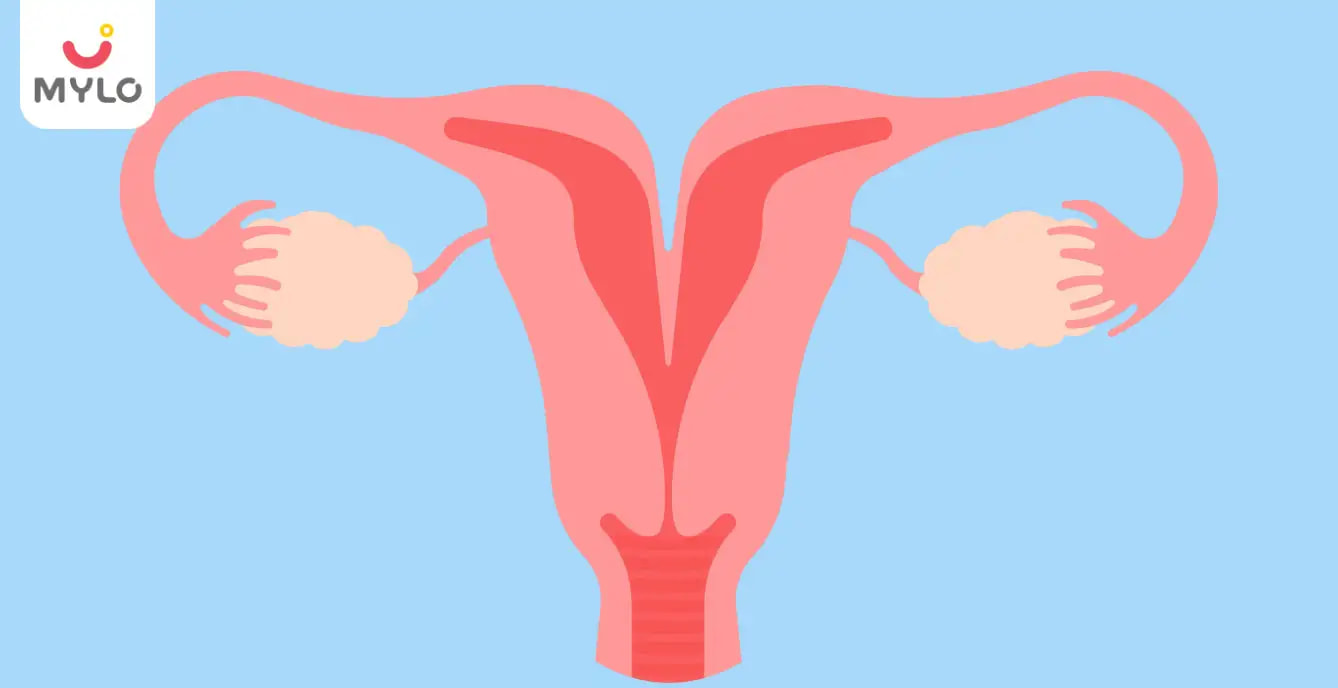Home

Women Specific Issues

Bicornuate Uterus: A Comprehensive Guide on Causes, Symptoms and Treatment Options
In this Article

Women Specific Issues
Bicornuate Uterus: A Comprehensive Guide on Causes, Symptoms and Treatment Options
Updated on 3 November 2023
Bicornuate uterus, also known as a heart-shaped womb, is a condition where the uterus is heart-shaped. About 3% of women worldwide have this congenital abnormality, which means it is something they are born with. Most women usually don’t figure out they have this condition until pregnancy because it usually doesn't cause any symptoms.
In this article, we will understand in detail about its meaning, types, symptoms, potential risks in pregnancy and precautions to take for a smooth journey.
What is a Bicornuate Uterus?
The simplest meaning of bicornuate uterus is an abnormality that divides your uterus into two separate parts, or "horns," by a septum to give it a heart shape.
The exact cause of this condition is not well understood, but it is thought to occur during the early development of the uterus in the womb. Some research suggests that it may be caused by a failure of the uterus to fuse properly during fetal development, while other studies have suggested a genetic link.
You may also like: Bulky Uterus: What You Need to Know About this Common Gynecological Issue
Bicornuate Uterus Types
Let us now understand the two types of heart-shaped uterus:
1. Bicornuate Unicollis Uterus
It is a subtype of bicornuate uterus characterised by a septum dividing the uterus into two "horns", and the cervix is fused to the septum. It is considered a rare variation and posses a lower risk.
2. Bicornuate Bicollis Uterus
It’s another subtype that divides the uterus into two "horns", and the cervix is in two separate parts. This condition is also a rare variation that causes similar issues but is less severe than the bicornuate uterus.
Bicornuate Uterus Symptoms
Some women with a bicornuate uterus may have no symptoms at all and may not even be aware of the condition. However, in some cases, it can cause the possible symptoms:
- Menstrual cramps or pain during periods
- Heavy or irregular periods
- Pain during intercourse
- Pain or discomfort in the pelvic area
- Difficulty getting pregnant
- Miscarriage or preterm labor during pregnancy
How is a Bicornuate Uterus Diagnosed?
A bicornuate uterus can be diagnosed through various imaging options, including ultrasound, magnetic resonance imaging (MRI), hysteroscopy, or a pelvic exam. These tests help visualize the shape and structure of the uterus and determine if it is heart-shaped or has a double uterus.
Bicornuate uterus ultrasound and MRI are the preferred methods for imaging uterine anomalies like a bicornuate uterus. During these imaging tests, the doctor can identify the external contour of the uterus, which is typically concave or heart-shaped. Accurate diagnosis is essential for appropriate management and treatment of the condition.
Potential Risks in a Bicornuate Uterus Pregnancy
The condition can cause numerous complications during pregnancy including:
1. Miscarriage
Increases the risk of miscarriage, especially in the first three months.
2. Preterm labor
A condition when labor begins before 37 weeks of pregnancy.
3. Placental problems
Placenta is a temporary organ that develops to provide oxygen and nutrients to the baby. Bicornuate uterus can cause bleeding during pregnancy and even separate the placenta from the uterus.
4. Breech position
The baby could be in a breech position. This could require a cesarean delivery.
5. Umbilical cord prolapse
A rare but serious complication where the umbilical cord drops through the cervix ahead of the baby.
Precautions for Bicornuate Uterus Pregnancy
If you are pregnant and have been diagnosed with a bicornuate uterus, here are certain precautions that you can take to ensure a healthy pregnancy:
-
Receive regular prenatal care to monitor any complications.
-
Take prescribed medications to help prevent preterm labour, pain or discomfort.
-
Work with the doctor to monitor the baby’s position. Head-first is an ideal position.
-
Report contractions to the doctor, as there is always a higher risk of preterm labour.
-
Prepare a delivery plan in advance.
Remember, a bicornuate uterus can cause complications during pregnancy. But many women with this condition have successful pregnancies with proper management.
Treatment Options for Bicornuate Uterus
There are three common treatment options for bicornuate uterus:
1. Bicornuate uterus surgery
Strassman metroplasty is a surgical procedure aimed at correcting the anatomical abnormality of the bicornuate uterus. It involves removing the septum that divides the two horns of the uterus, thus creating a more normal uterine cavity. Strassman metroplasty can improve pregnancy outcomes and reduce the risk of complications associated with bicornuate uterus.
2. Cervical cerclage
This procedure involves stitching the cervix closed to prevent premature dilation and miscarriage. Cervical cerclage is often recommended for women with bicornuate uterus who have a history of preterm labor or pregnancy loss. It helps to provide support to the cervix and reduce the risk of complications.
3. Myomectomy
In some cases, bicornuate uterus may be associated with the presence of uterine fibroids. Myomectomy is a surgical procedure that involves removing these fibroids from the uterus. By addressing the fibroids, myomectomy can help improve fertility and pregnancy outcomes in women with bicornuate uterus.
It's important to note that the choice of treatment depends on individual factors, such as the severity of the condition and the patient's reproductive goals. A thorough evaluation by a healthcare professional is necessary to determine the most appropriate treatment plan for each individual.
The Bottomline
In conclusion, a bicornuate uterus is a rare congenital condition characterized by a heart-shaped uterus with a deep indentation at the top. While it may not always cause significant concerns, it can increase the risk of complications during pregnancy, such as recurrent pregnancy loss and preterm labor. But with correct diagnosis and treatment, women with bicornuate uterus can go on to have a healthy pregnancy.
References
1. Kaur P, Panneerselvam D. Bicornuate Uterus. (2023). In: StatPearls [Internet]. Treasure Island (FL): StatPearls Publishing
2. Diaouga HS, Laurent HL, Yacouba MC, Mamane FLA, Rahamatou MG, Idi N, Nayama M. (2022). Bicornuate uterus and pregnancy: ambiguity diagnosis (a case report). Pan Afr Med J
3. Agarwal I, Tayade S, Sharma S. (2022). A Case Report of a Normal Pregnancy in a Bicornuate Uterus Through In Vitro Fertilization. Cureus.



Written by
Sanju Rathi
A Postgraduate in English Literature and a professional diploma holder in Interior Design and Display, Sanju started her career as English TGT. Always interested in writing, shetook to freelance writing to pursue her passion side by side. As a content specialist, She is actively producing and providing content in every possible niche.
Read MoreGet baby's diet chart, and growth tips

Related Articles
Related Questions
Hello frnds..still no pain...doctor said head fix nhi hua hai..bt vagina me pain hai aur back pain bhi... anyone having same issues??

Kon kon c chije aisi hai jo pregnancy mei gas acidity jalan karti hain... Koi btayega plz bcz mujhe aksar khane ke baad hi samagh aata hai ki is chij se gas acidity jalan ho gyi hai. Please share your knowledge

I am 13 week pregnancy. Anyone having Storione-xt tablet. It better to have morning or night ???

Hlo to be moms....i hv a query...in my 9.5 wk i feel body joint pain like in ankle, knee, wrist, shoulder, toes....pain intensity is high...i cnt sleep....what should i do pls help....cn i cosult my doc.

Influenza and boostrix injection kisiko laga hai kya 8 month pregnancy me and q lagta hai ye plz reply me

RECENTLY PUBLISHED ARTICLES
our most recent articles

Diet & Nutrition
গর্ভাবস্থায় আলুবোখরা: উপকারিতা ও ঝুঁকি | Prunes During Pregnancy: Benefits & Risks in Bengali

Diet & Nutrition
গর্ভাবস্থায় হিং | ঝুঁকি, সুবিধা এবং অন্যান্য চিকিৎসা | Hing During Pregnancy | Risks, Benefits & Other Treatments in Bengali

Women Specific Issues
স্তনের উপর সাদা দাগ: লক্ষণ, কারণ এবং চিকিৎসা | White Spots on Nipple: Causes, Symptoms, and Treatments in Bengali

Diet & Nutrition
গর্ভাবস্থায় পোহা: উপকারিতা, ধরণ এবং রেসিপি | Poha During Pregnancy: Benefits, Types & Recipes in Bengali

Diet & Nutrition
গর্ভাবস্থায় মাছ: উপকারিতা এবং ঝুঁকি | Fish In Pregnancy: Benefits and Risks in Bengali

Diet & Nutrition
গর্ভাবস্থায় রেড ওয়াইন: পার্শ্ব প্রতিক্রিয়া এবং নির্দেশিকা | Red Wine During Pregnancy: Side Effects & Guidelines in Bengali
- ইনার থাই চ্যাফিং: কারণ, উপসর্গ এবং চিকিৎসা | Inner Thigh Chafing: Causes, Symptoms & Treatment in Bengali
- গর্ভাবস্থায় ব্রাউন রাইস: উপকারিতা ও সতর্কতা | Brown Rice During Pregnancy: Benefits & Precautions in Bengali
- Velamentous Cord Insertion - Precautions, Results & Safety
- Unlock the Secret to Flawless Skin: 7 Must-Have Qualities in a Face Serum
- Unlock the Secret to Radiant Skin: How Vitamin C Serum Can Transform Your Complexion
- Gender No Bar: 10 Reasons Why Everyone Needs a Body Lotion
- Unlock the Secret to Radiant Skin How to Choose the Perfect Body Lotion for Your Skin Type
- Top 10 Reasons to Apply a Body Lotion After Every Bath
- Communication in Toddlers: Milestones & Activities
- How to Improve Vocabulary for Toddlers?
- A Comprehensive Guide to Understanding Placenta Accreta
- Vulvovaginitis in Toddlers Causes, Symptoms and Treatment
- A Comprehensive Guide to Understanding Cerebral Palsy in Children
- Bitter Taste in Mouth During Pregnancy: Understanding the Causes and Remedies


AWARDS AND RECOGNITION

Mylo wins Forbes D2C Disruptor award

Mylo wins The Economic Times Promising Brands 2022
AS SEEN IN
















- Mylo Care: Effective and science-backed personal care and wellness solutions for a joyful you.
- Mylo Baby: Science-backed, gentle and effective personal care & hygiene range for your little one.
- Mylo Community: Trusted and empathetic community of 10mn+ parents and experts.
Product Categories
baby carrier | baby soap | baby wipes | stretch marks cream | baby cream | baby shampoo | baby massage oil | baby hair oil | stretch marks oil | baby body wash | baby powder | baby lotion | diaper rash cream | newborn diapers | teether | baby kajal | baby diapers | cloth diapers |








